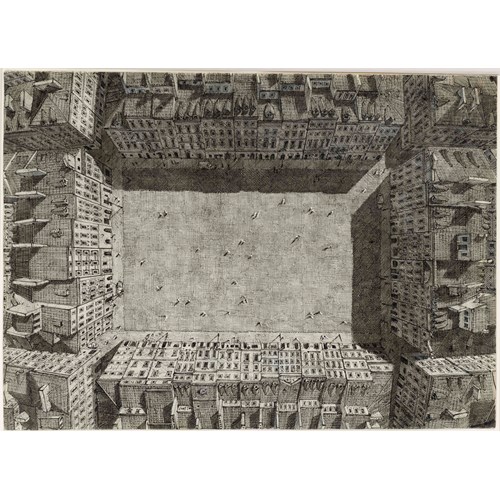Giovanni Domenico TIEPOLO
Landscape with a Watermill
Medium Pen and brown ink and brown wash
Dimension 13 x 21.4 cm (5¹/₈ x 8³/₈ inches)
As one early 20th century English writer, who was also an avid collector of Tiepolo drawings, has described these landscape studies, which he regarded as works by Giambattista, ‘They are accurate sketches from nature of buildings, mostly villas and farms in full sunlight, evidently made for the purpose of acquiring facility in handling strong lights and shadows, in which the master attained such extraordinary skill. All were obviously done with extreme rapidity...Some of the outlines may have been made with the pen, but most are brush work. The surfaces in shadow are given with simple washes, the depth of shade being indicated almost always by the tone of the wash alone without hatching. In this power of precise modulation of tint without either exaggeration or monotony, Tiepolo stands perhaps alone with Rembrandt, of whom this group of drawings in curiously reminiscent. But whereas Rembrandt’s farms are always represented in co-ordinated space as incidents in complete compositions, the Tiepolo sketches are merely detached studies. Though such farm buildings are a familiar feature in Venetian pictures from early times, it does not appear that Tiepolo ever introduced them into his finished works.’
Devoid of any human presence, these drawings in pen and wash are evocative of the heat and shadows of an Italian summer. In them, as Michael Levey has written, ‘Each shape is firmly reduced to essentials, moulded by the light and baked by the heat, so that from them there seems to exude a smell of dry straw and tile and earth, like the perennial scent of the Italian countryside in summer.’ None of these drawings appear to have been used in any painted works by Giambattista or Domenico Tiepolo, and they seem instead to have been done as a record of the unfamiliar countryside beyond their native Venice.
It seems likely that among the albums of drawings kept in the Tiepolo studio was a book of landscape sketches in pen and ink wash, and that this was one of several albums of Tiepolo drawings acquired, around the middle of the 19th century, by the English amateur artist, writer and collector Edward Cheney (1803-1884), who lived in Venice in the 1840s. The Cheney albums were in turn purchased, after his death, by the London dealers E. Parsons and Sons, and their contents dispersed over the next two or three decades. Thirty-five of the landscape drawings were bought, probably from Parsons, by the artist Alphonse Legros and eventually dispersed at two auctions in 1918. Others were acquired, also probably from Parsons, by the artists and designers Charles Ricketts and Charles Shannon, and later bequeathed to the Fitzwilliam Museum in Cambridge.
A small but significant group of eight landscape drawings by Giambattista Tiepolo is now in the Fitzwilliam Museum in Cambridge, while another set of five landscapes is in the Museum Boijmans van Beuningen in Rotterdam. Other landscape drawings of this type are today in the collections of the Kupferstichkabinett in Berlin, the Fogg Art Museum in Cambridge, Massachusetts, the British Museum and the Courtauld Gallery in London, the J. Paul Getty Museum in Los Angeles, the Metropolitan Museum of Art and the Pierpont Morgan Library in New York, the Fondation Custodia (Frits Lugt Collection) in Paris, and elsewhere.
The present sheet may have been one of the large group of Tiepolo landscape drawings acquired from the dealers E. Parsons and Sons by the etcher and draughtsman Alphonse Legros (1837-1911), and may have thence passed into the collection of Francis (Frank) Edward Bliss (1847-1930), who came to own over two thousand prints by Legros. By 1970, this drawing is recorded in the collection of the American bibliophile Douglas H. Gordon, Jr. (1902-1986), who assembled a fine group of drawings which included works by Italian, Dutch, French and English artists. Gordon owned another landscape drawing by Domenico Tiepolo, depicting a Water Gate and of identical dimensions to the present sheet, which is today in the collection of Marco Brunelli in Milan.
Medium: Pen and brown ink and brown wash
Signature: Inscribed (in a modern hand) G. B. Tiepolo / Landscape with Watermill / building[?] + trees on the verso.
Faintly inscribed from the Bliss Coll. on the verso.
Dimension: 13 x 21.4 cm (5¹/₈ x 8³/₈ inches)
Provenance: Probably from an album of landscape drawings by Giambattista and Domenico Tiepolo acquired in Venice by Edward Cheney, London and Badger Hall, Shropshire
Probably by descent to his nephew, Colonel Alfred Capel Cure, Blake Hall, Ongar, Essex
Probably his sale, London, Sotheby’s, 29 April 1885, as part of lot 1042 (bt. Parsons)
Probably E. Parsons and Sons, London
Probably Alphonse Legros, London
Probably his sale, London, Sotheby’s, 3-4 July 1918, lot 120 (as G.B. Tiepolo: Study of an Old Mill. 6 1/2 x 7 1/4 in.)
Possibly Francis Edward Bliss, London (according to an inscription on the verso)
Douglas Huntly Gordon, Annapolis and Baltimore, Maryland, by 1970
Anonymous sale, New York, Christie’s, 30 January 1997, lot 85
Kate de Rothschild, London, in 1999
Acquired from her by Susan Lyall, Swinbrook, Oxfordshire and Little Cassiobury, Bedford Hills, New York.
Literature: George Knox, Tiepolo: A Bicentenary Exhibition 1770-1970, exhibition catalogue, Cambridge (MA), 1970, unpaginated, no.83b; George Knox, Un quaderno de vedute di Giambattista e Domenico Tiepolo, n.d. [1974], p.81, no.68; Kate de Rothschild, Kate de Rothschild: Master Drawings. A Celebration, 35 Years in the Art World 1972-2007, n.d. (2008), unpaginated, no.20.
Exhibition: Cambridge (MA), Fogg Art Museum, Tiepolo: A Bicentenary Exhibition 1770-1970, 1970, no.83b; Baltimore, Baltimore Museum of Art, Baltimore Collects: French and Italian Drawings, 1715-1814, 1984 [no catalogue].
Plus d'œuvres d'art de la Galerie




_T638451686580251969.jpg?width=500&height=500&mode=pad&scale=both&qlt=90&format=jpg)



